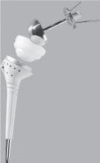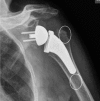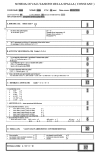Onlay versus Inlay humeral steam in Reverse Shoulder Arthroplasty (RSA): clinical and biomechanical study
- PMID: 31821285
- PMCID: PMC7233693
- DOI: 10.23750/abm.v90i12-S.8983
Onlay versus Inlay humeral steam in Reverse Shoulder Arthroplasty (RSA): clinical and biomechanical study
Abstract
Background and aim of the work: Reverse shoulder arthroplasty (RSA) is becoming treatment of choice in glenohumeral arthropathies with massive lesion of the rotator cuff, due to a gradual extension of indications and new designs that provide better outcome. In this study we compared two different reverse shoulder prosthesis designs, defined as Inlay (or typical Grammont type) and a relatively new model defined as Onlay (that preserves tuberosity bone stock). We analyzed clinical, biomechanical and radiological outcomes, as well as complications of RSA in these two groups.
Methods: We performed a prospective study on a population of 42 patients undergoing Reverse Shoulder Replacement by a single expert surgeon. We consider 21 patients (group A) who underwent to reverse shoulder replacement with a curved onlay steam with 145° inclination (Ascend Flex group, Wright medical, Memphis, TN, USA) and 21 patients who underwent to reverse shoulder replacement with a traditional Inlay Grammont steam (Modular Shoulder System SMR, Systema Multiplana Randelli; Lima-LTO, San Daniele del Friuli, Italy) between August 2010 and October 2018. We studied the following items: active range of motion (AROM), radiological parameters (lateralization shoulder angle LSA, Distalization Shoulder Angle DSA), functional scale (Constant-Murley Score), post-operative complications (infection, aseptical implant mobilitazion, residual pain, scapular notching, fractures, tuberosity reabsorbtion, dislocation, bleedings, nerve palsy, pulmonary embolus).
Results: A significant improvement in ROM and functional score (Constant Shoulder Score) were observed in both groups. Group A (Onlay design 145°, medial tray) provides improvement in adduction, extension and external rotation compared to group B. No significant differences were found in abduction, external rotation and forward flexion. At 6 months follow-up, pain relief was detected in all patients. Although complications occur in a high percentage of patients in literature, no postoperative complications were observed in our cases series.
Conclusions: Our results showed how RSA is a real solution to improve quality of life and to restore pain-free shoulder ROM in patients where cuff tear arthropathy occurs. Onlay design 145° may provides better active external rotation, extension, adduction: it is necessary to continue follow up and include more cases to prove these data.
Conflict of interest statement
Each author declares that he or she has no commercial associations (e.g. consultancies, stock ownership, equity interest, patent/licensing arrangement etc.) that might pose a conflict of interest in connection with the submitted article
Figures











References
-
- Neer CS, Craig EV, Fukuda H. Cuff-tear arthropathy. J Bone Joint Surg. 1983;65(9):1232–1244. - PubMed
-
- Smith CD, Guyver P, Bunker TD. Indications for reverse shoulder replacement: a systematic review. J Bone Joint Surg Br. 2012;94:577–83. - PubMed
-
- Boileau P, Watkinson D, Hatzidakis AM, Hovorka I. Neer Award 2005: The Grammont reverse shoulder prosthesis: results in cuff tear arthritis, fracture sequalae, and revision arthroplasty. J Shoulder Elbow Surg. 2009;15:527–540. - PubMed
-
- Ackland DC, Roshan-Zamir S, Richardson M, Pandy M. G. Moment arms of the shoulder musculature after reverse total shoulder arthroplasty. J Bone Joint Surg Am. 2010;92:1221–30. - PubMed
-
- Parsons IM, Weldon EJ, Titelman RM, Smith KL. Glenohumeral arthritis and its management. Phys Med Rehabil Clin N Am. 2004;15:447–74. - PubMed
Publication types
MeSH terms
LinkOut - more resources
Full Text Sources
Research Materials

